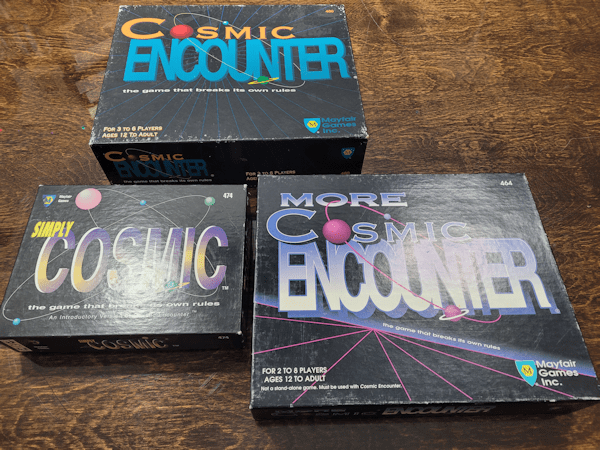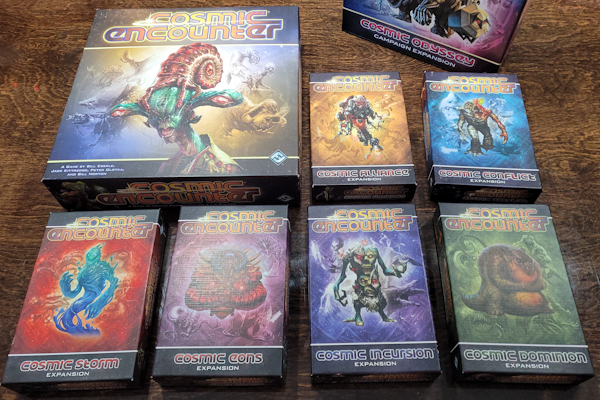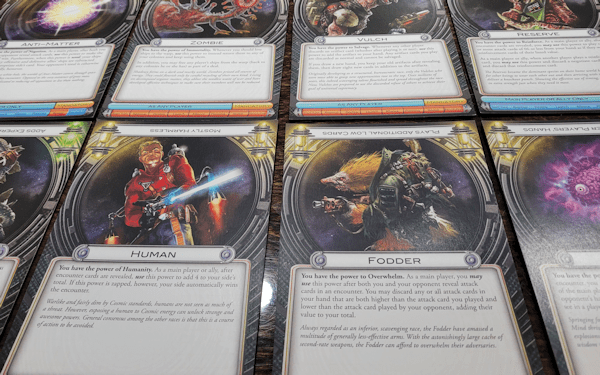Cosmic Encounter is a classic. It is a bright and shining star in the history of board game design. When I introduce the game to new players, I have encountered a few who hear ‘variable player powers’ and begin to doze off. I get it. The idea of an asymmetric game allowing players to break the rules in unique ways is fairly common these days.
These days.
Set the wayback machine to 1977, however, and this game is nothing short of revolutionary. It’s like the film Citizen Cane. Kids watching it for the first time today look at how the story unfolds, how it was filmed, what it does, and they have no idea! They think it’s quaint, or even old fashioned, but they do not see the greatness. They fail to grasp how every movie they watch in a theater or over some streaming service today owes that film a sizable debt. It is not a stretch to say that modern cinematic storytelling began with Citizen Cane. Likewise, the modern concept of variable player powers and asymmetric game design began with Cosmic Encounter.
Let’s take a look at this masterpiece.
A Little History

The original Cosmic Encounter was published by Eon Games. I never had the pleasure of playing this edition. My only recollection of this version was from an article in Games magazine. In the article, one of the designers (Peter Olotka) was telling the interviewer about a conversation during an early playtest. His opponent revealed an attack card with a value of 19, and said something to the effect that “since my people are all dyslexic, this changes from a 19 to a 91.” Peter smiled, revealed his attack card with a value higher than 19 but nowhere near a 91, and said “that’s good, because my people are perpetual losers and can only win a combat if they lose it.” And from here was born the idea that every single faction in the game would have some power that changed the nature of the game when they played. The Eon Games edition of the game would spawn eleven expansions. These range from being boxed and sold in stores to being included inside magazines.

West End Games would republish the game in 1986. But the next major step of the game would come in 1991 when Mayfair Games took over. This version smoothed the rougher edges of the game, making for a much cleaner experience. The base game included 49 races. They would follow up the base game with More Cosmic Encounter, an expansion that required a box almost as big as the original, and included another 54 races, moons, and more. An introductory version of the game called Simply Cosmic came later with 8 races. With these three boxes, you never had to worry about the idea of playing the same game twice. The Mayfair edition was beloved, but sadly went out of print.

In 2008, Fantasy Flight Games decided it was time to make a new edition. When I first read about this, I got nervous. I wrote to Fantasy Flight begging them to be careful with this property. Cosmic Encounter is one of those games that has a rather rabid fanbase, and I mean that in the best way possible. This is not a game you want to mess up. If you do, that group of fans is going to let you know. I was assured by Fantasy Flight that the people working on it were as passionate about the game as I was. They were not kidding.
The improvements Fantasy Flight made to the game are almost countless. From the production values to the artwork to the cleaning up of the timing rules, there is not an element of the game that they did not look at carefully, and make as good as it could be. The latest edition of Cosmic Encounter is as close to perfection as the physical world will allow. It is flawless.
How to Play
The core rules, if you strip away the alien races and their powers, are quite simple. You start with five planets in your home system, each with a colony of four ships (for a total of 20 ships per player). The object of the game is to establish colonies (i.e., have at least one ship) on five planes outside your home system while maintaining colonies on at least three of your home system planets. Players are dealt cards from the Cosmic Deck. This deck of cards contains attack cards (which have numeric values), negotiate cards, reinforcement cards, and other cards with various effects.
The acting player starts their turn by regaining one ship from an area called The Warp, if they have any ships there. Then they draw a card from the Destiny Deck. This deck is composed of color-coded cards that indicate the player with whom they are about to have an encounter (the defending player). If they draw their own color, they can have an encounter with anyone.
Using a large token called the hyperspace gate, the acting player points at a planet in the defending player’s home systems and places one-to-four of their ships onto the gate as the attacking force; the defending player will defend with any ships they have on the chosen planet. Each player may then ask for aid from any of the other players (or not). If a player is not invited into the conflict by the acting or defending player, they cannot participate on that side. Invited players may stay out of the fight, or they may commit one-to-four of their ships to a side in which they were invited.

The acting and defending players then select an encounter card from their hand and place it face down on the table. Once both players have selected a card, they are revealed.
- If both players reveal attack cards, the value of each card is added to the number of ships involved in the encounter on that side. The side that has the higher number wins (ties go to the defender). Any player involved in the conflict may play reinforcement cards from their hand to add more strength to their side.
If the acting player wins, the defending player loses all ships on the planet to the warp. All ships that were played in aid of the defending player are also lost to the warp. All ships that were committed by the acting player and their allies are moved onto the planet, establishing new colonies.
If the defending player wins, the acting player and their allies lose all ships committed to the encounter to the warp. The defending player keeps their colony, and their allies may regain a ship from the warp, or draw a card from the Cosmic Deck, for each ship they had in the fight.
- If one player reveals an attack card and the other reveals a negotiate card, the side with the attack card wins and everything above takes place except that the allies from the negotiating side gain nothing. The negotiating player also gets compensation by drawing a number of cards from the winning player’s hand equal to the number of ships lost.
- If both players reveal negotiate cards, they have one minute to make a deal. All allies on both sides of the encounter gain nothing. If the two players involved cannot come to an agreement, they both lose three ships as a penalty.
If the acting player wins their first encounter (or is able to make a deal), they have the option of having a second encounter. After a second encounter, passing on a second encounter, or losing the first encounter, play passes to the next player after checking to see if anyone has won the game.
But Wait! There’s More!
If what I described above were all there was to this game, this would not be one of the greatest games of all time. But this is one of the greatest games of all time, so let’s talk about what else is going on here.

Alien Powers: The base game comes with 50 alien races to choose from. Each alien race in the game has an ability that can alter the way things work. They are broken into three classes of difficulty: easy (green), moderate (yellow), and hard (red). Some examples include:
- Amoeba: the power to ooze. They may increase or decrease the number of ships they have in an encounter after encounter cards are selected, but before they are revealed. Using this ability, they can have more than the normal limit of four ships involved.
- Fido: the power to fetch. They may take a card discarded at the end of an encounter and offer it to another player. If the card is refused, they keep it. If the card is accepted, they may draw a card from the deck or retrieve a ship from the warp.
- Sorcerer: the power of magic. As the acting or defending player, after the encounter cards have been selected but before they are revealed, they may swap them so that they reveal their opponents card and vice versa.
- Spiff: the power to crash land. If you are the acting player, lost an encounter by ten or more points where both players played attack cards, one of your ships that would have been lost to the warp instead crash lands onto the planet as if you had just won the encounter.
- Tick-tock: the power of patience. At the start of the game, they set ten tokens aside. Each time a player wins an encounter as the defender, or a successful deal is made, they remove one of these tokens. If they remove the last token, they immediately win the game.
Flares: The Cosmic Deck will include a flare card for each alien race in the game (as well as a random selection of others). Flare cards, when played, allow a player to use a slightly muted version of someone else’s alien power; or, if a player plays the flare card of their own alien race, a beefed-up version of their alien power.
Artifacts: The Cosmic Deck may include artifacts that grant boons or inflict penalties when played.
Technologies: Players can include the optional technology rules that allow them to research powerful technologies to add even more variation.
Zaps: The cosmic deck has zap cards that can be used to negate other actions.
And so on… the base game has a lot of options. But that’s not all!
Now How Much Would You Pay?
As with the original Eon version, and the Mayfair edition, Fantasy Flight has added expansions to the game. Each expansion has added not only more aliens, but new options for play. These include:
- Cosmic Incursion: adds 20 alien races, a new player color, and the reward deck. Adds rules for cosmic quakes.
- Cosmic Conflict: adds 20 alien races, a new player color, and the hazard deck.
- Cosmic Alliance: adds 20 alien races, a new player color, and cards for playing with 7+ players.
- Cosmic Storm: adds 25 alien races, and space stations.
- Cosmic Dominion: adds 30 alien races, and the reward deck.
- Cosmic Eons: adds 30 alien races, the essence cards, and alliance dials.
- Cosmic Odyssey: adds 30 alien races (plus 12 alternate timeline versions), and a whole slew of other elements that play into a complete campaign game.
Add in promo material, and there are 238 alien races with unique powers to choose from. There are over 20 official variants and optional rules that can be added into the game as desired. The earth has not existed long enough to enjoy every possible way this game can be set up. All you need is three or more players and a couple of hours, and you are set for an amazing board gaming experience!
If you don’t have three players, the good folks over at Fantasy Flight Games have even created a two-player version of the game called Cosmic Encounter Duel.
Conclusions and Final Thoughts
The original game box boldly stated that this was a game for everybody. I believe that is true.
Are you someone who enjoys games drenched in strategic and tactical considerations? Cosmic Encounter is for you! The game’s basic rules and alien races offer a multitude of crunchy choices; each player needs to consider their opponents and their powers before making any decisions.
Are you someone who enjoys games with a dynamic social component? Cosmic Encounter is for you! The game’s basic rules and alien races offer an ever-shifting environment ripe for good social engineering; each player must ensure everyone at the table sees their alien power through the right lens.
Are you someone who enjoys games with a role-playing element? Cosmic Encounter is for you! The game’s basic rules and alien races offer ample opportunities to get into character; some of the alien powers are actually dependent upon it.
Are you someone who enjoys board games? Cosmic Encounter is for you!
Cult of the New: the power to resist. If you have exhausted all excuses to play Cosmic Encounter, you must submit.











Add Comment